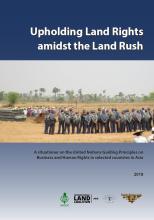Land Library Search
Through our robust search engine, you can search for any item of the over 73,000 highly curated resources in the Land Library.
If you would like to find an overview of what is possible, feel free to peruse the Search Guide.
/ library resources
Showing items 1 through 9 of 195.The five Central Asian countries (Kazakhstan, Kyrgyz Republic, Tajikistan, Turkmenistan, and Uzbekistan) are among the Europe and Central Asia Region’s most vulnerable to climate change; building resilience is thus a priority for poverty reduction and shared prosperity in Central Asia.
Tenure cuts across many economic and social issues. Here we present a few of the key considerations that a company should internalize in order to act consistently with the intent of the VGGT.
To support the practical application of the OECD-FAO Guidance, in early 2018 the OECD and FAO launched an implementation pilot with over thirty companies and industry initiatives.
We must agree as a nation, that several mistakes have been made in our land deals in recent years. We were stampeding in the wrong direction without adequately consulting beneficiaries i.e. those who are directly affected, those individuals and groups who suffer if anything goes wrong.
This publication discusses the relevance to land and agriculture of the United Nations Guiding Principles on Business and Human Rights (UNGP BHR), and provides an overview of the state of the UNGP BHR’s implementation in Bangladesh, Cambodia, India, Indonesia, Nepal, and the Philippines.
You can carry out your own analyses on poverty and ecosystem services with the GIS data made available, some of them being publicly released for the first time. All data are accompanied by metadata.
OpenCommunityContracts.org is a repository of publicly available community-investor or community-government contracts and agreements relating to agriculture, forestry, mining, oil and gas extraction and other natural resource projects.
Agricultural productivity in the highlands of Ethiopia is threatened by severe land degradation, resulting in significant reductions in agricultural GDP.








